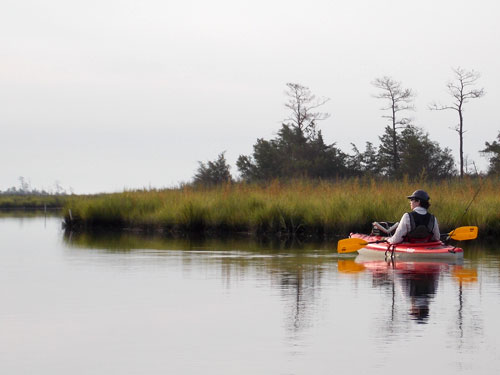The following page provides information about kayaks and kayaking accessories.
Types of Kayaks

Kayak designs include sit in kayaks (SIK), sit on kayaks (SOK), stand up kayaks, motorized models, and other styles. Each design has its advantages as well as disadvantages.
Sit in kayaks usually offer plenty of room for storage and a more protected, dryer experience.
Sit on kayaks tend to be wetter but less vulnerable to flooding.
When choosing a kayak that will be used primarily for fishing, factors such as tracking, stability, and seaworthiness are important.
Tracking is a measure of how a vessel reacts under power. A good fishing kayak will move in a straight line and resist wandering as the kayaker paddles the craft. Tracking is important, especially for applications where fishermen will be traveling long distances.
Stability is another key factor. A fishing kayak must be stable enough to allow anglers to cast lines and catch fish. A few models are stable enough to allow anglers to stand while fishing.
Agility is another important characteristic of a good fishing kayak. Anglers often fish around pilings, rocks, and other obstructions which demand the ability to steer and maneuver quickly.
Stand up kayaks feature a wide SOK hull design. Some models include pontoons that swing out when fishing. When deployed, the rear mounted pontoons give the kayak enough stability to allow an angler to stand and fish.
A leaning post is used often used with stand up kayaks to provide extra stability while fishing. Stand up kayaks are useful for applications such as sight casting in clear shallow areas or as a fly fishing platform.
Two person kayaks have a variety of advantages. They allow a pair of anglers to work in tandem, sharing paddling and other activities. When fishing this can be a huge advantage as one person can control the craft while the other fishes. In general, two person kayaks perform poorly with only one occupant.
Safety Equipment
Depending on conditions, safety equipment will vary greatly. Short trips in sheltered areas during fair conditions may require only basic safety gear while more advanced trips sometimes warrant the utmost in equipment.
These are some examples of safety gear for kayaking:
personal flotation device or PFD
helmet
eye protection
pump
air bladder
knife
pliers
cell phone
hand held marine VHF radio
flares
lights
sound-producing device
paddle lanyard
spare paddle
floats and lanyards for all equipment
waterproof pouches
Buy Kayaks Online
To purchase equipment online, visit our Kayaking Gear online store or browse the selection of fishing kayaks at Amazon.